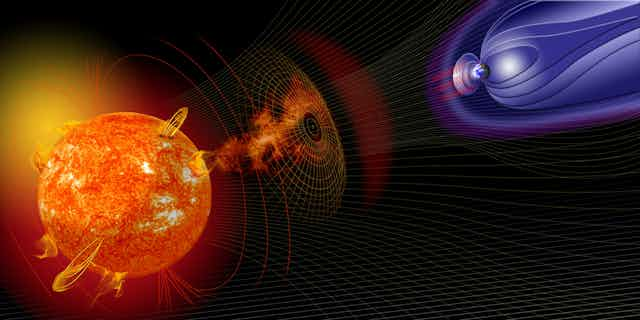You may have read the sun’s magnetic field is heading for a change in field polarity - meaning it will flip upside down - and could have ripple effects throughout the entire solar system.
So what does this mean for us on Earth? To predict its effects, we first need to understand how - and why - this phenomenon occurs.
Well, first of all, the sun itself isn’t tipping - just its magnetic field. The very existence of magnetic fields in the heavens was first demonstrated by American solar astronomer George Ellery Hale in 1908, based on his spectroheliograph observations of sunspots, areas of intense magnetic activity on the sun’s surface.
It was later realised that magnetic fields are dotted across the solar surface, collected in “flux tubes” ranging in size from the smallest scales we can see up to sunspots many times the diameter of Earth.

But the sun as a whole also has a “global” magnetic field, oriented more or less north-south. So we can think of the sun as a large N-S magnet, like our Earth, but with smaller variously (but not randomly) oriented and continually evolving mini-magnets distributed over its photosphere (visible surface) and throughout its corona (extended atmosphere).
However, unlike our Earth, the sun’s large scale magnetic field flips over on a regular basis, roughly every 11 years. (Actually, Earth’s flips too, very irregularly. The last time was 780,000 years ago. But that’s another story.)
What’s going on?
Solar magnetic reversals occur close to solar maximum, when the number of sunspots is near its peak, though it is often a gradual process, taking up to 18 months.
Indeed, as is the case now, one pole often lags the other by some months. Currently, the sun has two positive magnetic poles!

The reversal will probably be complete within the next three to four months.
If you are puzzled by the idea of a magnet with two poles of the same polarity (which is impossible), it’s not quite that bad.
All the other smaller magnets scattered across the solar surface balance it out; there is always exactly the same amount of positive and negative magnetic flux piercing the photosphere (it’s a fundamental law of physics).
The reversals occur because of a slow migration towards the poles of detritus from the break-up of old opposite-polarity sunspots. This has happened faster in the northern hemisphere than in the south during this cycle, which is why the south lags.
What will happen to us?
So, what does this mean for Earth and for the rest of the solar system? The sun’s magnetic field dominates the heliosphere, the bubble of ionised gas (plasma) formed by the solar wind and enveloping our solar system out to more than 100-times the sun-Earth distance (100 Astronomical Units).

The solar wind carries with it magnetic field, and so the sun’s overall north-south polarity is propagated throughout the heliosphere, leaving a wavy “current sheet” separating the two polarities in space.
The heliospheric magnetic field and its current sheet partially protect us from cosmic rays originating out in the galaxy and beyond. When the sun reverses polarity, so does the heliosphere, with some delay.
During the changeover, heliospheric protection against cosmic rays is barely compromised, remaining at a high level typical of solar max. Earth’s own magnetic field continues to shield us too.
Nevertheless, the heliosphere’s field reorganisation can enhance the waviness of the current sheet, meaning Earth passes through it many times during its orbit around the sun.
This can provoke “space weather” events such as geomagnetic storms that may have implications for satellites and other technologies, such as radio blackouts.

An imperfect universe
Greek philosopher Aristotle taught that the heavens are perfect and immutable. This dogma, based more on philosophical predisposition than on observation and data (a practice that has unfortunately come back into fashion in recent years), weighed heavily on Western thought for nearly two millennia.
When the great revolutionary Galileo Galilei turned his new telescope to the sun in 1612 and saw sunspots - imperfections on the “perfect” orb - the foundations of natural philosophy were shaken to the core.

Modern science grew from the rubble. Forevermore, science would be based on experiment and observation.
It is well to remember this central role taken by our mutable and imperfect sun in the intellectual evolution of humanity at this time when our peripatetic star’s magnetic field is flipping upside down.
Mankind has lived through innumerable solar field reversals with little or no effect. The difference now is our reliance on technology, making us more vulnerable to their influence.
However, large solar storms, associated with flares and coronal mass ejections, are of more practical concern as they affect Earth-orbiting satellites, telecommunications, electric power grids, and other technologies.
The fact the current solar maximum is historically very weak suggests that damaging events might be less frequent for some years to come, though that is no guarantee the next “killer solar storm” is not just around the corner.
It will certainly come one day. Will we be ready?

